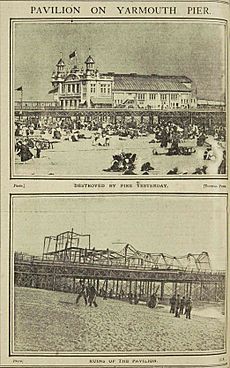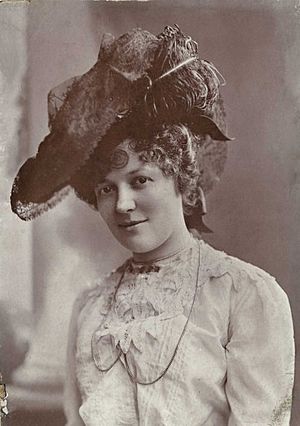Evaline Hilda Burkitt facts for kids
Evaline Hilda Burkitt (born July 19, 1876 – died March 7, 1955) was a brave British suffragette. She was a member of the Women's Social and Political Union (WSPU), a group that fought for women's right to vote. Hilda was a strong activist for women's rights. She went on hunger strike in prison and was the first suffragette to be force-fed by the authorities. Between 1909 and 1914, she was force-fed 292 times. She was the last woman to be treated this way in Holloway Prison. She received a special award called the WSPU's Hunger Strike Medal for her courage.
Contents
Hilda's Early Life and Activism
Evaline Hilda Burkitt was born in Wolverhampton in 1876. She was one of nine children. Her parents were Laura and Reuben Burkitt. All the children, including the girls, received a good education. Hilda loved reading, needlework, and gardening.
She lived with her wealthy grandparents until she was 25. Then, she moved to Birmingham to live with her older sister Christobel. Hilda started working as a secretary in Sparkbrook, Birmingham. In 1907, she joined the Women's Social and Political Union (WSPU). She was inspired after hearing Nell Kenney and Emmeline Pankhurst speak.
When the WSPU opened a branch in Birmingham in 1908, Hilda took charge of their publicity in the Midlands area. During her time as an activist, she sometimes used the name "Byron." Her sister, Ida Lillian Burkitt, was also a suffragette. Lillian was an actress and photographer. She was arrested for trying to enter the House of Commons in 1908. Lillian and Christobel were among 50 women arrested in 1908 after a "Women's Parliament" protest.
Protests and Prison
Hilda was arrested four times in 1909. Her last arrest that year was in September. She threw a stone at the train of the Prime Minister, H. H. Asquith. This happened as his train left Birmingham New Street Station. He had visited Birmingham for a meeting. Even with many police around, suffragettes climbed onto a nearby roof. They threw slates down at the Prime Minister.
In court, Hilda explained that her actions were for a political cause. When she arrived at Winson Green Prison, Hilda and other suffragettes sang songs. They refused to go into their cells or undress. All of them immediately started a hunger strike. They were then force-fed. Hilda was the first to be force-fed. She would go through this 292 times between 1909 and 1914. While in prison, she spoke out against the harsh treatment.
When she was released from Winson Green prison on October 18, 1909, she bravely shouted "Votes for Women!" to a small crowd. On November 5, Hilda received the WSPU Hunger Strike Medal for her courage.
In 1912, she was sentenced to four months in prison for breaking windows as a protest. She was released early due to her health after going on hunger strike. In November 1913, she was arrested in Leeds. She was accused of trying to burn down a grandstand at a football ground with Clara Giveen. She went on hunger strike again and was released in December 1913. Hilda also helped organize the WSPU branch in Stoke-on-Trent for a few months that year.
Brave Actions and Force-Feeding
After being released from Leeds Prison under the "Cat and Mouse Act," Hilda managed to avoid being caught again for a while. In 1914, she and fellow suffragette Florence Tunks took part in some bold actions. They caused damage to two wheat stacks at a farm. They also damaged the Pavilion at the Britannia Pier in Great Yarmouth and the Bath Hotel in Felixstowe. No one was inside the Pavilion or the hotel during these events. In court, the two women refused to answer questions. They sat on a table and chatted, turning their backs to the magistrates.
On May 29, 1914, Hilda was sentenced to two years in HM Prison Ipswich. In prison, she went on a hunger and thirst strike. She was force-fed throughout her time before being moved to Holloway Prison. Another suffragette released from Holloway in July 1914 said Hilda was being force-fed up to four times a day. She was very unwell after each feeding. Even though she was generally healthy, Hilda often complained of chest pains at night. Her weight also dropped a lot. Prison records often said Hilda was "hysterical" during the force-feeding.
On August 7, 1914, Hilda wrote to the Home Office asking to be released. She wrote, "I’ve been in prison since April 28th and have been forcibly fed during the whole time, 292 times so far." She pleaded, "reply to my Petition at once, as if I should die through my fasting, my death will lie at your door." She also wrote that she was "ready to lay down my life, to bring about the Freedom of my Sex." She was released from prison on September 1, 1914. She promised not to take part in militant activities again. She was the last suffragette to be force-fed in Holloway Prison.
Later Life and Remembering Hilda
In 1916, Hilda married Leonard Mitchener. Later, their marriage ended. In 1939, she was living in St Albans and working as a "Confectioner and Cake Maker." Her family described her as a gentle and quiet person. She only became angry when she faced unfair rules, like not being allowed a mortgage without a man to guarantee it.
In her later years, she lived with her sister Ida Lillian Burkitt in Morecambe. Evaline Hilda Mitchener passed away on March 7, 1955, in Blackburn Royal Infirmary in Lancashire.
Legacy
In 2014, The Felixstowe Society put up a plaque to remember the events at the Bath Hotel in Felixstowe in 1914. The plaque marks 100 years since the hotel was damaged by Hilda Burkitt and Florence Tunks. It is on what is left of the building today.
From November to December 2018, a special art display of Hilda's portrait was placed in Birmingham New Street Station. This was the same station where she had thrown a stone at the Prime Minister's train in 1909. The artwork was called "The Face of Suffrage." It was a huge photo mosaic on the floor, covering 200 square meters. The artwork was based on a photograph taken by Hilda's older sister, Ida Lillian Burkitt. Ida was also a suffragette, as well as an actress, photographer, and nurse. The artwork was made from 3,724 photos of women from the West Midlands from the 1900s, plus pictures of modern women. Artist Helen Marshall created it to celebrate 100 years since women gained the right to vote.




